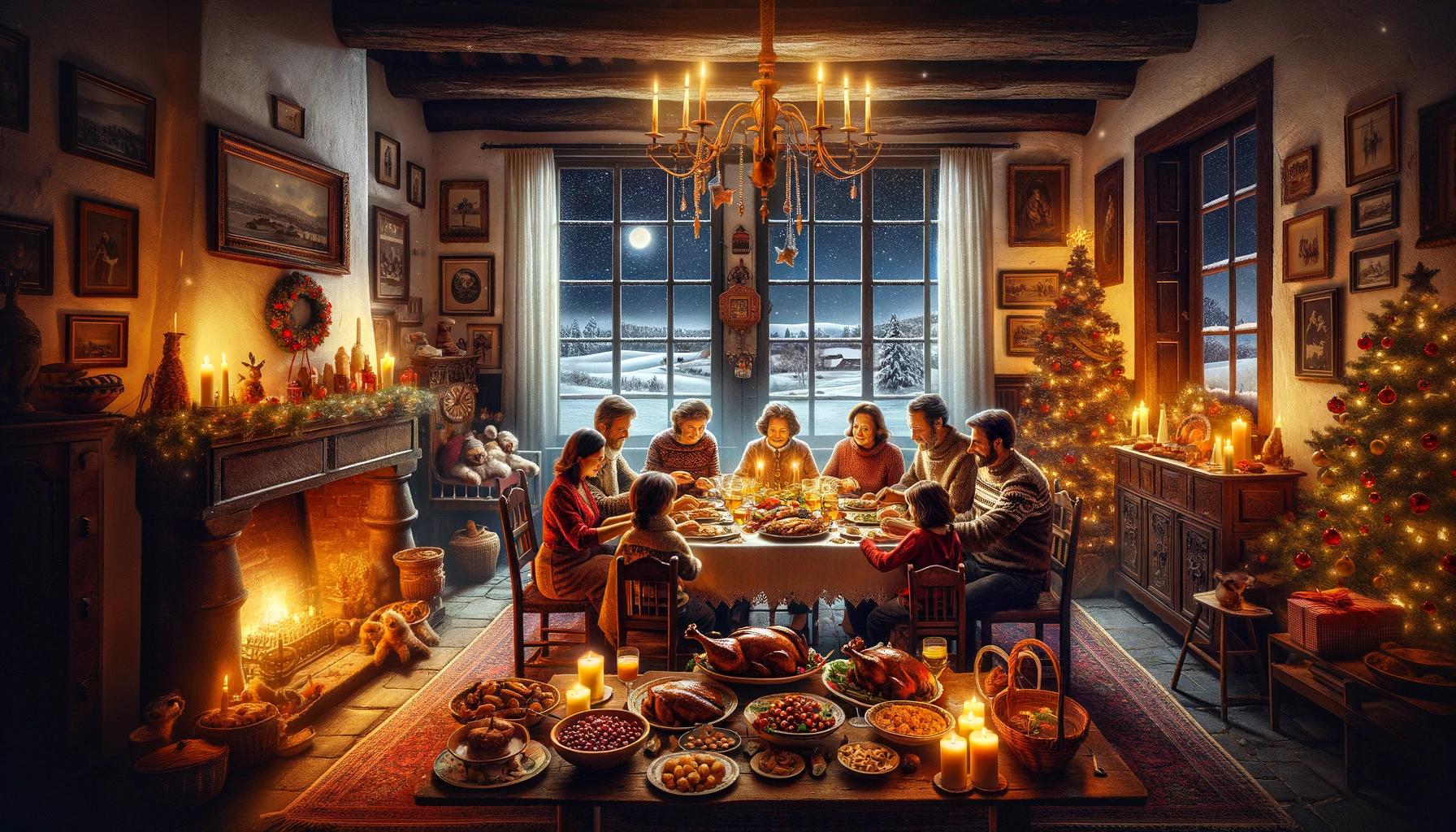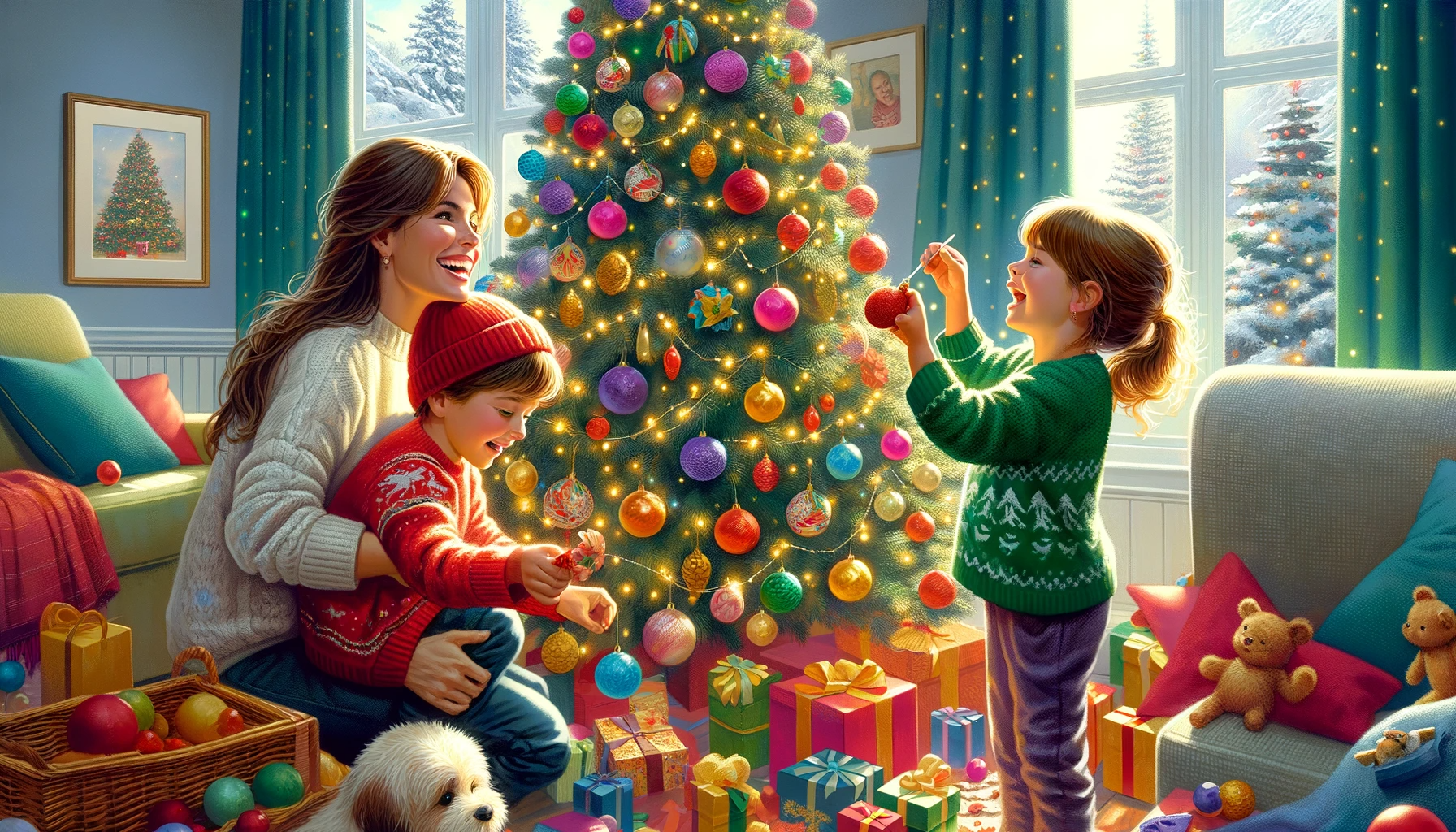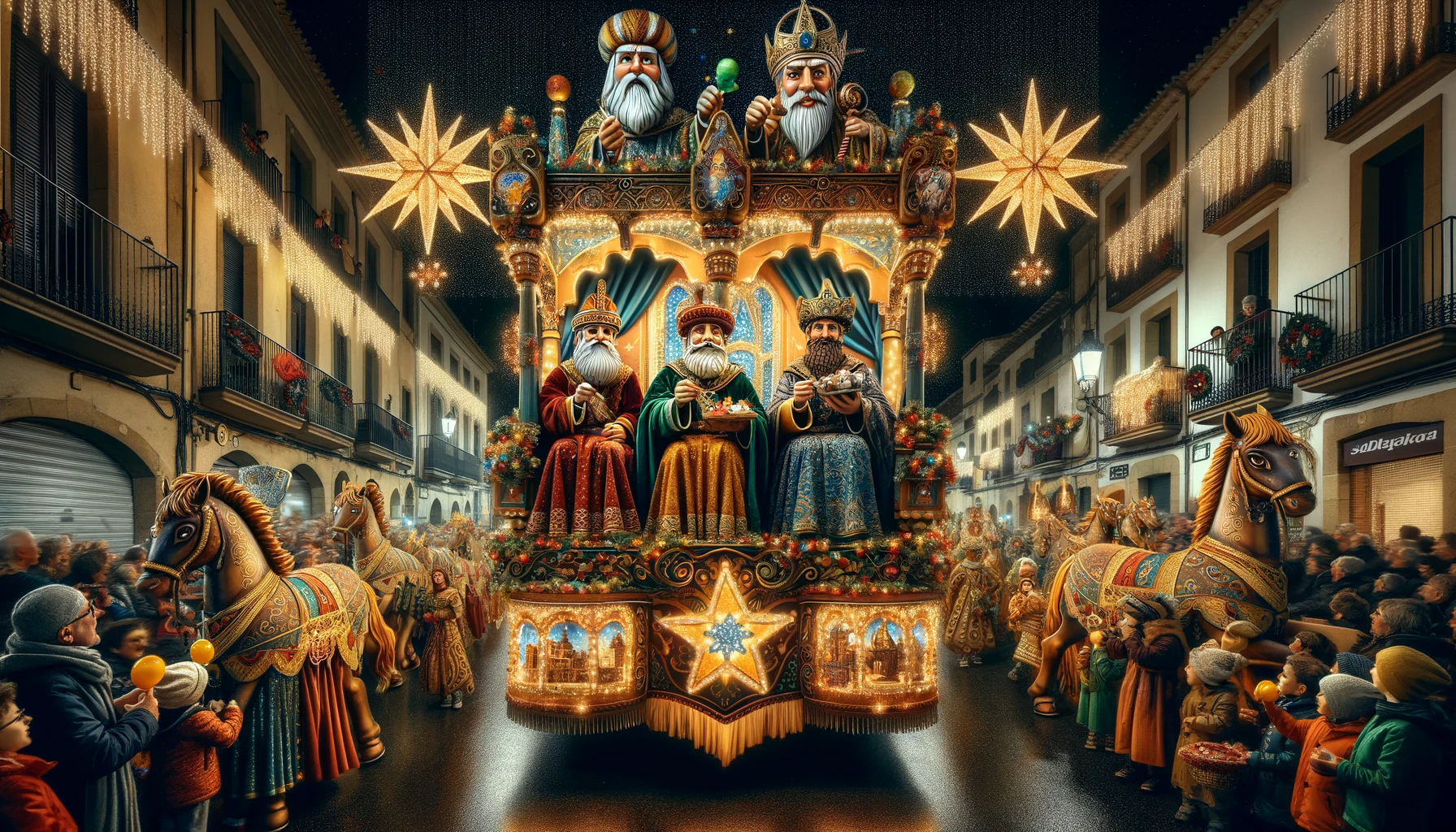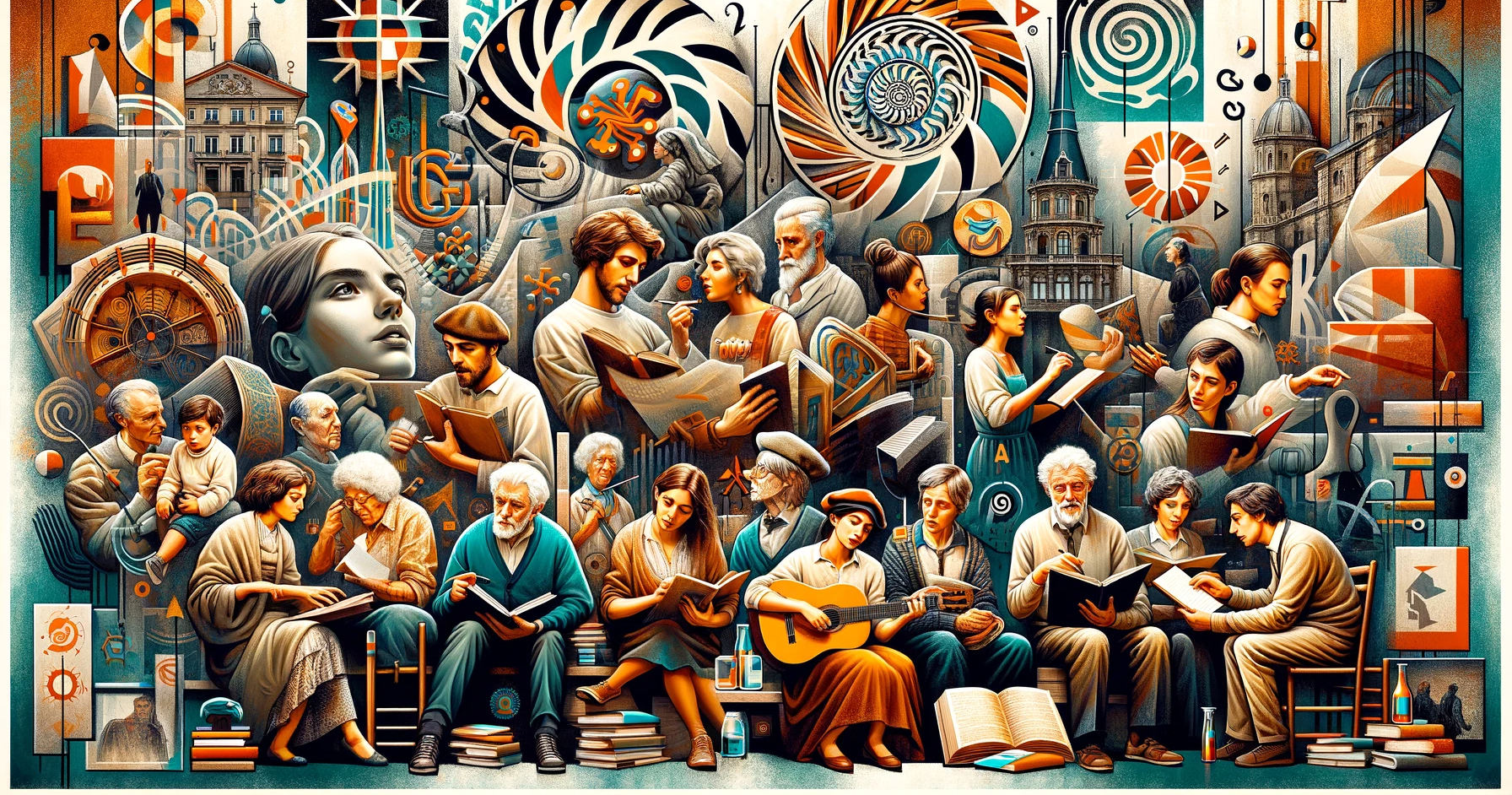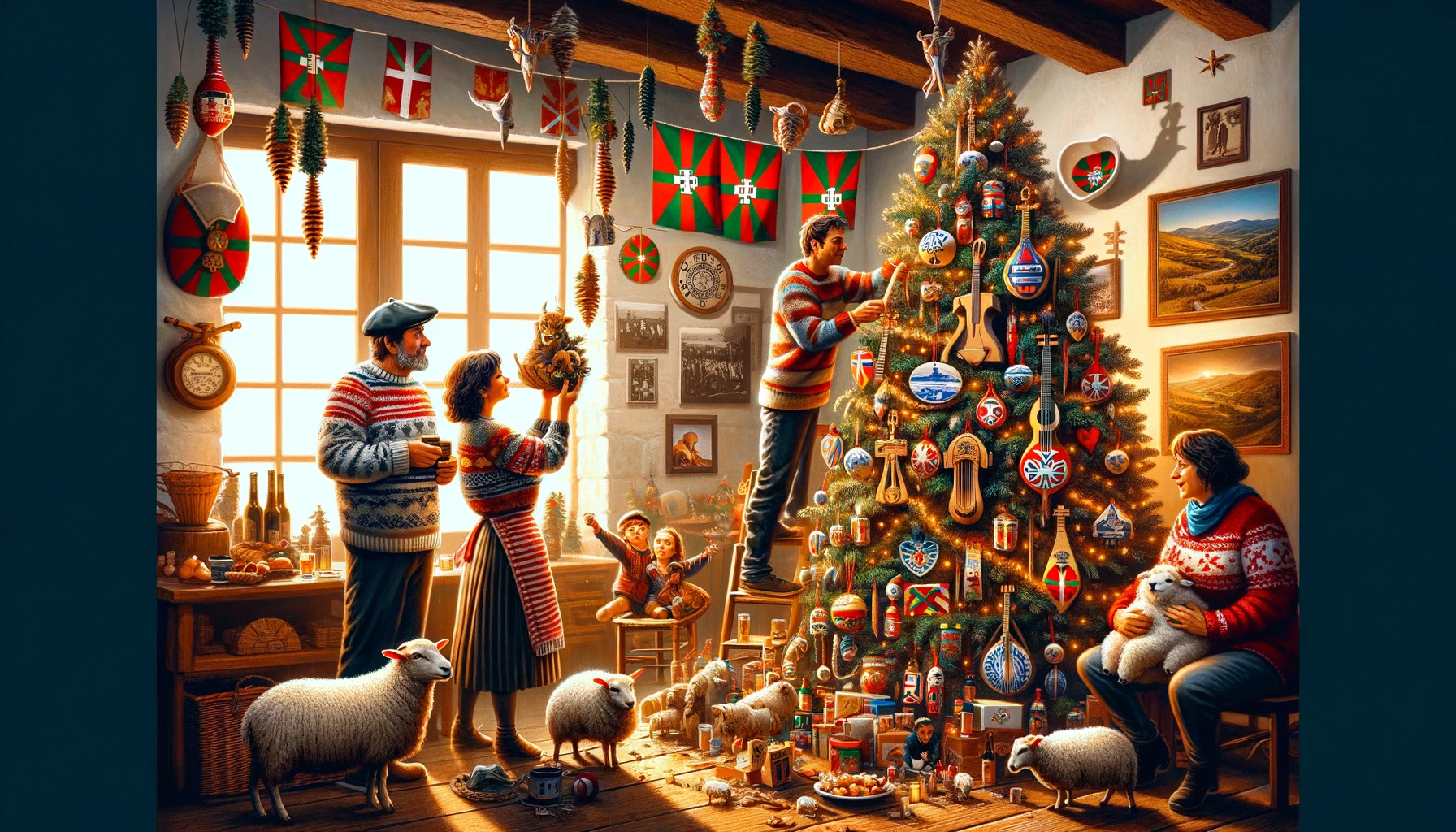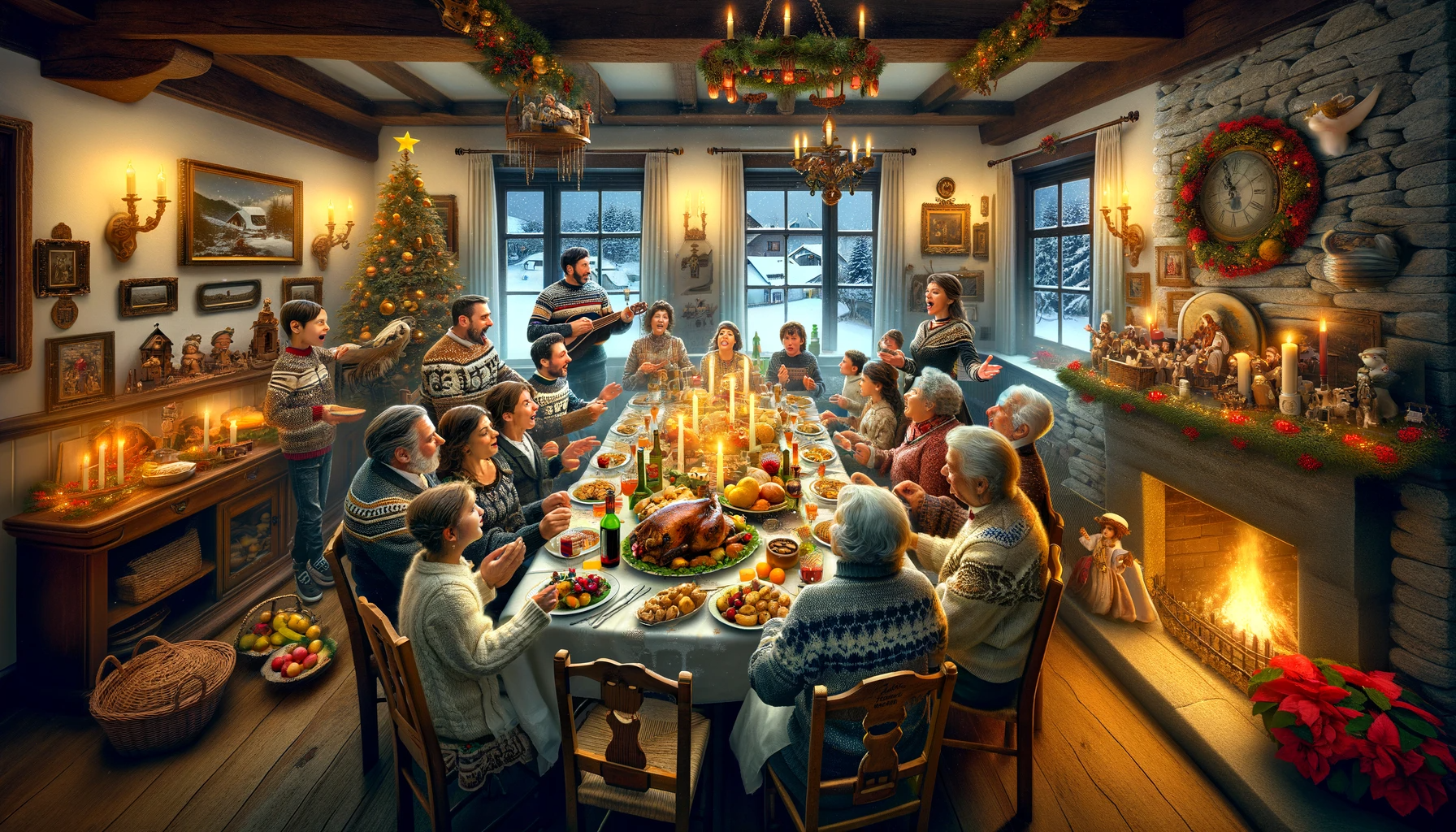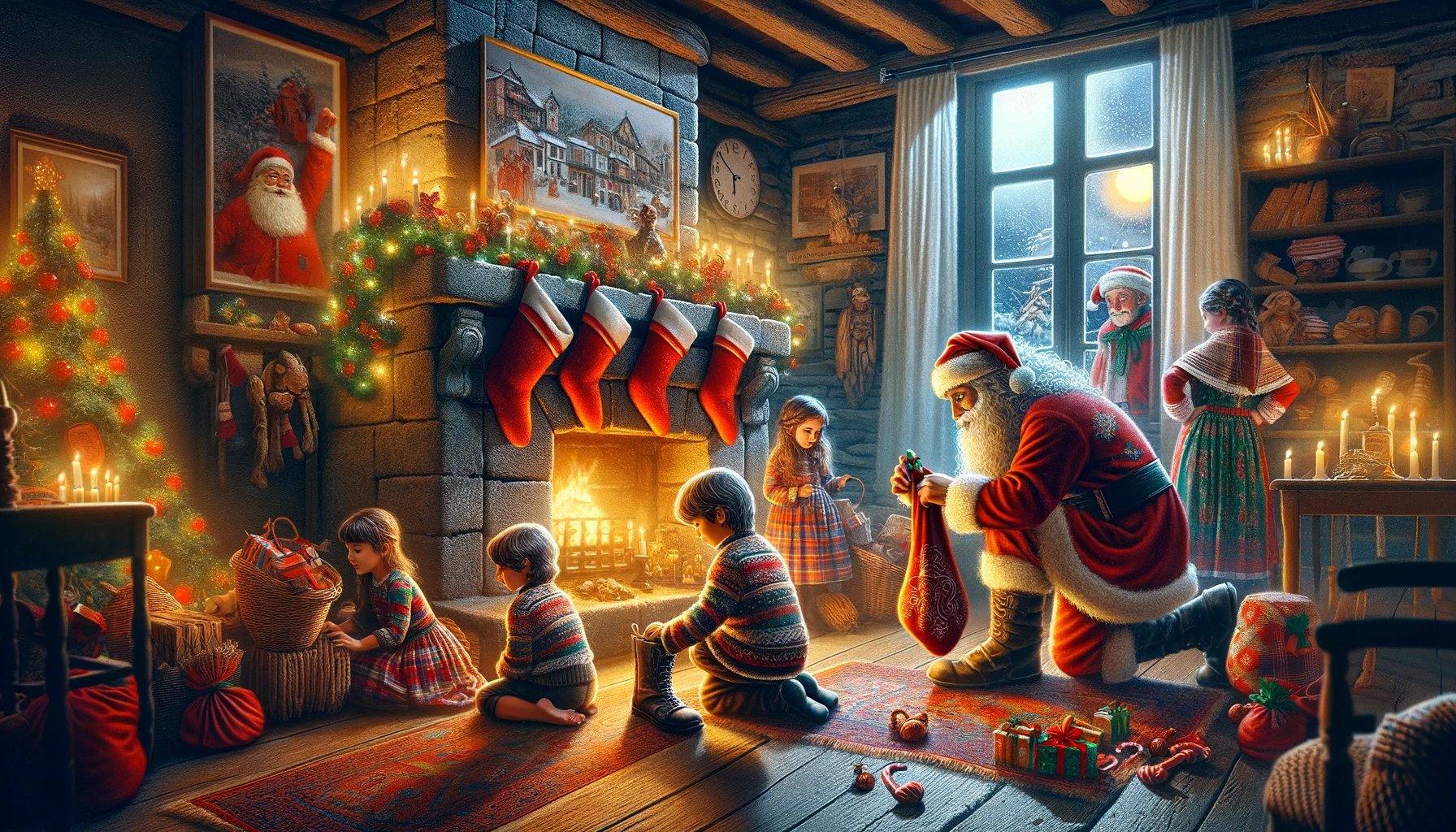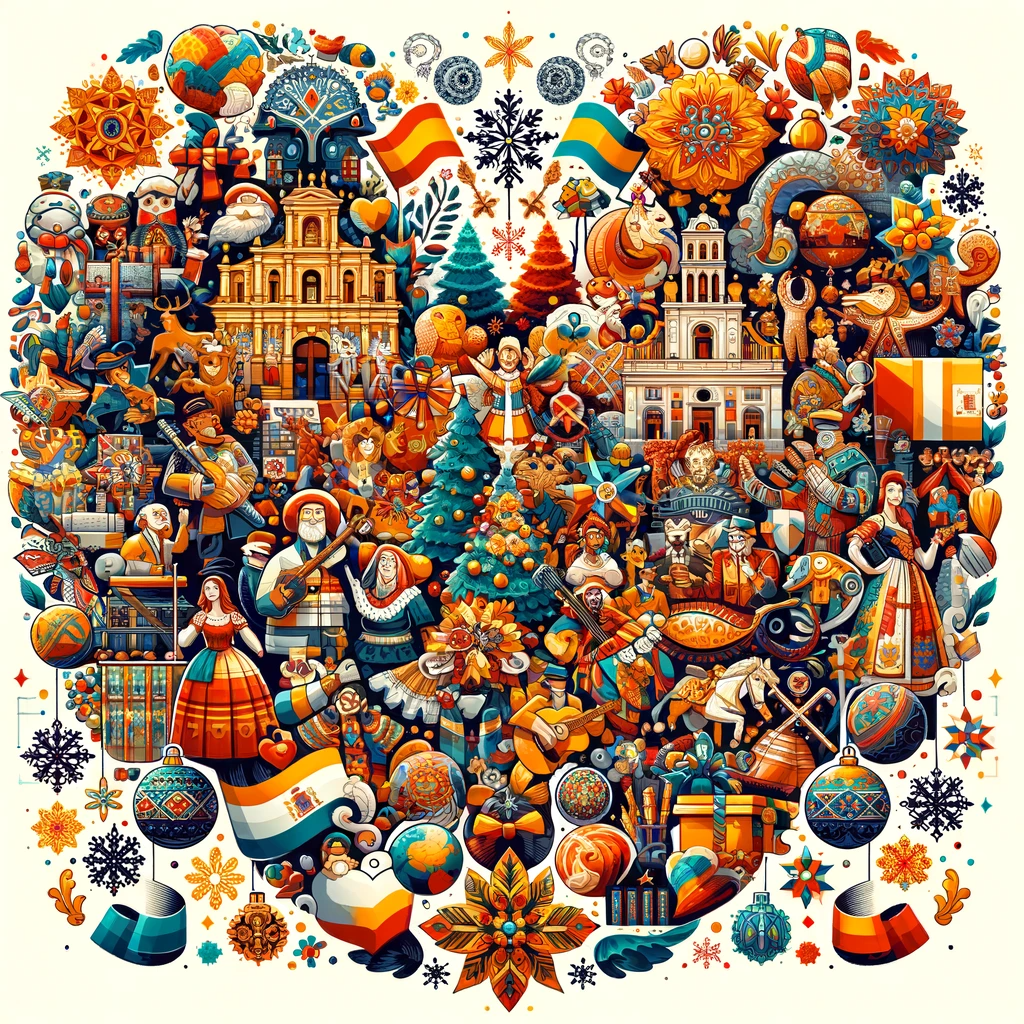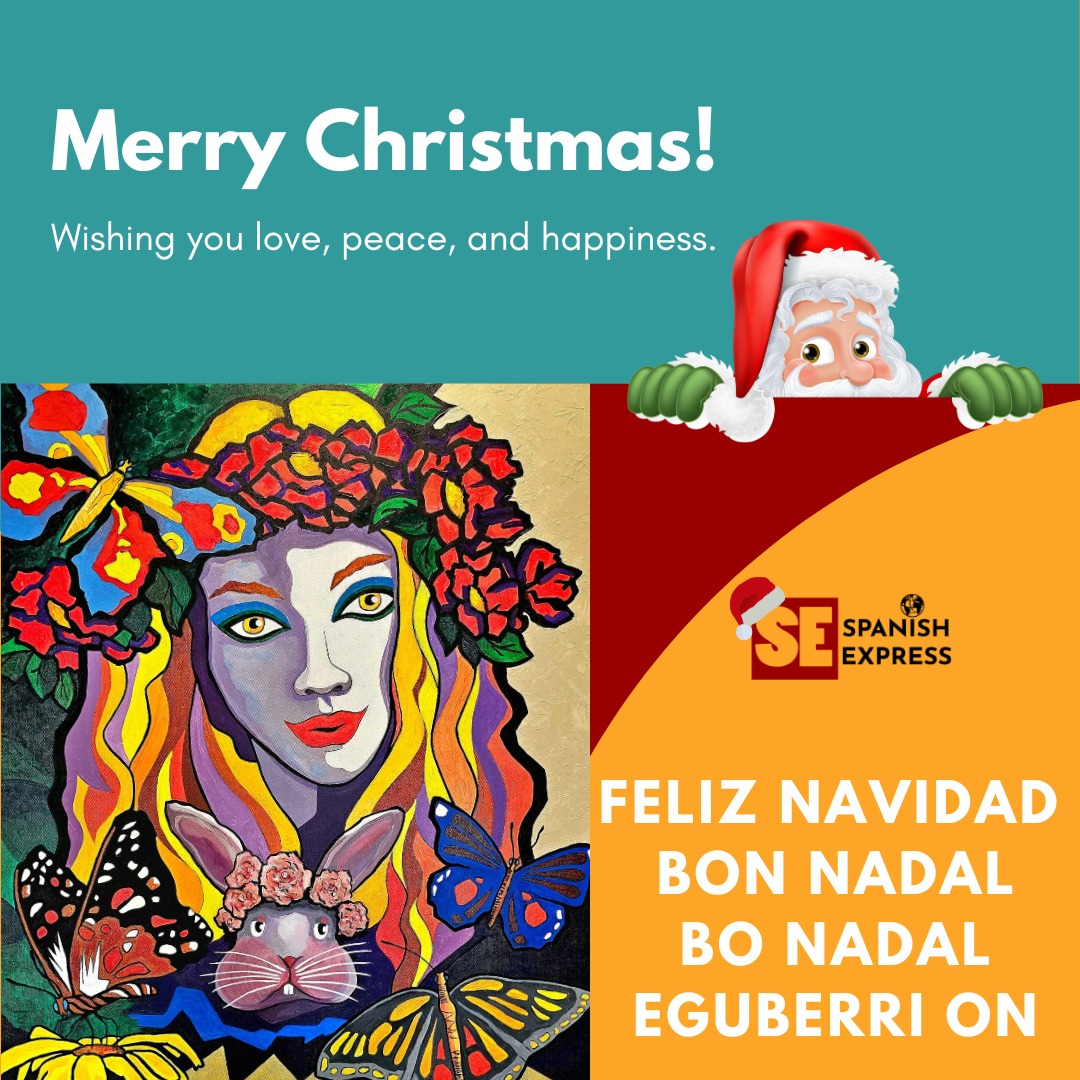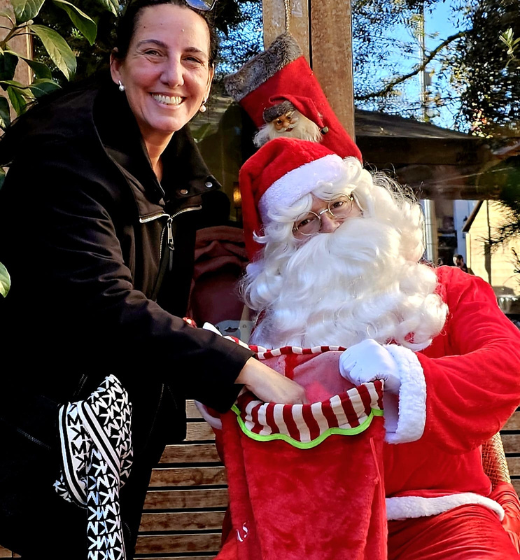

Want to know how to say Merry Christmas in Spanish, Castilian, Catalan, Basque, and Galician? I am here to help you learn this greeting in these romance languages. So, stay here and keep reading.
Spain is full of diverse cultures and the Christmas greetings here are exchanged mostly in the 4 Official Languages. Each language has its own unique way of saying “Merry Christmas.”
Imagine walking through the streets of Spain during the festive season, hearing these greetings in Castilian, Catalan, Basque, and Galician. This variety showcases Spain’s rich cultural mix.
In this article, you’ll learn how to greet in these four languages happy holidays. It’s like taking a trip through Spain’s colourful and diverse traditions, all united by the festive spirit of Christmas.
Castilian (Castellano o Español)
Castilian Spanish, also known as Castellano, is a Romance language which originated in the northern and central regions of Spain.
It evolved from spoken Latin and was influenced by Arabic during the peninsular hegemony of Al-Andalus in the early Middle Ages.
Castilian Spanish became the official language of Spain in the 15th century after the merger of the kingdoms of Castile, Leon, and Aragon.
King Alfonso X the Wise played a significant role in the standardisation of written Castilian in the 13th century. This language contains many words of Arabic origin and has differences in accent and vocabulary in various regions of Spain.
Spanish is the official language of Spain and is spoken by nearly 500 million people worldwide.
How to say Merry Christmas in Castilian
In Castilian, we say “Feliz Navidad,” to wish “Merry Christmas.” It is more than just a seasonal greeting but a cultural emblem.
Alongside “Feliz Año Nuevo” for “Happy New Year,” these phrases encapsulate the essence of Spain’s public holiday spirit.
In streets, homes, and hearts, these words resonate, carrying the joy and warmth of the festive season. These words are carriers of centuries-old traditions and echo in lively family gatherings and festive city squares.
Christmas Eve and Castilian Traditions
Christmas Eve in Castilian culture is a tapestry of traditions. As the clock ticks towards Christmas Day, families unite over hearty Christmas dinner which is basically a practice deeply rooted in Spain’s social fabric.
This evening is not just a meal. It’s a celebration of togetherness that reflects the nation’s soul in the Christmas season.
On the other hand, the transition to New Year’s Eve, marked by the Gregorian calendar, sees Spain embracing new beginnings.
These traditions are deep in Castilian life. They mix history and current celebrations. Christmas Eve and New Year’s Eve are times for reflection and looking forward.
The Christmas Tree in Castilian-Speaking Regions
The Christmas tree, adorned with sparkling lights and festive ornaments is essential in Castilian-speaking regions.
This tradition goes beyond decoration; it’s a symbol of the season’s spirit. The ritual of gift giving, nestled under these trees, is a core aspect of Christmas.
Families and friends exchange gifts, a practice embodying generosity and affection. As they deliver gifts and they bid farewell to the year with “Happy New Year” wishes, the tree witnesses these moments of joy and kinship.
In every lit bulb, Christmas lights and wrapped Christmas presents lies the essence of Castilian Christmas, a time for celebration and togetherness.
The Three Wise Men (known as “Los Reyes Magos”)
In Spain, the Three Wise Men are central to Christmas. They are known as “Los Reyes Magos“. This tradition is more prominent than Father Christmas or Santa Claus.
The Three Wise Men are deeply rooted in Spanish and Catalan traditions. Their arrival is celebrated on January 5th. This event is called “La Cabalgata de Reyes“, or The Three Wise Men Parade. It’s a major event.
Melchior, Gaspar, and Balthasar are the Three Wise Men. They arrive on the night of January 5th. In the parade, they ride on floats. They travel through cities and towns. They give sweets and gifts to people, especially children.
Spanish children write letters to the Three Wise Men. They express their wishes in these letters. They leave the letters in specific places.
On the night of January 5th, children put their shoes by windows or doors. It’s believed that the Three Wise Men fill these shoes with gifts. This happens if the children have been good all year.
Father Christmas or Santa Claus is also known in Spain. But, the Three Wise Men are more important culturally. This tradition is linked to the biblical story of the Magi. They brought gifts to baby Jesus.
This cultural focus on the biblical story is important. It combines with lively parades and gift-giving. Thus, the Three Wise Men tradition is central to the holiday season. This is true in all of Spain, including Catalonia.
Eating the Twelve Grapes: A Time-Honored Tradition of Welcoming the New Year in Spain
Eating twelve grapes is a New Year’s Eve tradition in Spain. It involves eating grapes at midnight. Each grape represents a month of the upcoming year. This custom is believed to bring good luck.
The tradition started in Madrid in the late 19th century. In 1909, there was a surplus grape harvest. This led to promoting grapes as a treat for the new year. The practice became popular all over Spain.
The ritual is about eating twelve grapes at midnight. People eat one grape with each clock chime. It’s a bit challenging to eat all twelve before the last stroke. In city squares, people gather for this. Large clocks there add to the excitement.
Each grape stands for a wish for the new year. Eating them is seen as a positive start for each month. This tradition is fun and festive. It is also a cultural symbol. It emphasizes family, unity, and shared experiences.
Many Spanish Speaking Friends and Family enjoy this tradition. It brings them together with joy and optimism. It’s a way to start the new año y felicidad. This custom shows how traditions can deepen celebrations. It connects people to their heritage. It also maintains a sense of continuity across generations.
As festive tunes like “Feliz Navidad” by José Feliciano play in the background, the joyful spirit of Spain’s holiday traditions shines brightly.
Catalan (Català)
A Romance language with roots deep in the Pyrenees
Catalan is a Romance language with deep roots in the Pyrenees. It has a unique linguistic journey. It stands out from other Romance languages. Its distinct journey began in the 9th century. During this time, historical and political changes were happening. Catalan started to differ from other Romance languages.
Catalan’s origins are linked to the Carolingian Empire. This empire had a big influence over the region. There was also a mix of different languages and cultures in the Pyrenees. Because of this, Catalan became a unique language. It was shaped by interactions with various languages and cultures.
The Suppression of Catalan Identity: Language Repression During Franco’s Regime in Spain
Francisco Franco ruled Spain from 1939 to 1975. During this time, the Catalan language faced severe repression. Franco took power after the Spanish Civil War. He aimed to centralize Spain and create a uniform Spanish identity. This effort included targeting regional languages like Catalan.
The Franco regime saw regional languages as a threat. It wanted a unitary Spanish state. So, it suppressed linguistic and cultural diversity. Policies were made against using languages other than Spanish. This greatly affected Catalan speakers.
Catalan’s Echo: Where the Language Resonates Across Borders and Cultures
Catalan is mainly spoken in the northeastern Iberian Peninsula. It is concentrated in Catalonia, Valencia, and the Balearic Islands. These areas are in Spain. It is also spoken in the Principality of Andorra. Additionally, Catalan is found in other regions. There are Catalan-speaking communities in France’s Eastern Pyrenees. It is also spoken in the city of Alghero. Alghero is in Sardinia, Italy.
Here’s a rough estimate of the number of Catalan speakers in these regions:
- Catalonia (Spain): Approximately 7 million people.
- Valencia (Spain): There are communities where Catalan is spoken, but it is not the majority language. Valencia has its own variant of the language known as Valencian.
- Balearic Islands (Spain): The number of speakers is around 1.1 million.
- Andorra: Catalan is one of the official languages, and it is spoken by the entire population of around 77,000.
- Eastern Pyrenees (France): In the Pyrénées-Orientales region, there are about 100,000 people who speak Catalan or a dialect of Catalan.
- Alghero (Sardinia, Italy): It’s estimated that about 20,000 people speak a variant of Catalan in Alghero.
Christmas Eve Celebrations in Catalonia
Christmas Eve in Catalonia is a mix of many traditions. It combines cultural heritage with festive celebrations. This blend creates a unique and special experience for families.
The core of this celebration is “La Nit de Nadal” or “Christmas Night“. It’s a time for families to come together. They share a festive meal and exchange gifts. The table features traditional Catalan dishes. These dishes are a delight and show the region’s food heritage.
A key dish is “Escudella I Carn d’Olla“. It’s a meat and vegetable stew. This dish symbolizes abundance and togetherness. It is a central part of the celebration.
How to Say Merry Christmas in Catalan Language
In Catalan, Merry Christmas is “Bon Nadal.” This phrase is a celebration of their cultural identity.
The tradition of Father Christmas is unique church services. This simple phrase symbolises the festive spirit in Catalonia.
Caga Tió: Unveiling Catalonia’s Unique Christmas Tradition
“Caga Tió” is a unique Christmas tradition in Catalonia, Spain. It’s also called “Tió de Nadal” or “Christmas Log“. This tradition involves a log-shaped figure with a face and a red hat. The log is usually covered with a blanket.
This tradition starts on December 8th, the Feast of the Immaculate Conception. On this day, the Caga Tió is brought into the home. From then until Christmas Eve, children “feed” it. They give it nuts, dried fruits, and sweets.
The main event is on Christmas Eve. Children gather around the Caga Tió. They sing traditional songs. These songs encourage the log to “defecate” treats. The children hit the log with sticks while singing. This is to get more sweets and presents.
After this ceremony, the Caga Tió has given all its treats. This symbolizes gift sharing and joy. The tradition includes folklore, music, and humor. It’s a loved and fun part of Catalonia’s Christmas.
Santa Claus in Catalan Traditions
In Catalan traditions, Santa Claus is not the central figure in Christmas celebrations; instead, the focus is often on other unique characters. One such character is Tió de Nadal, also known as Caga Tió, as mentioned earlier. However, there is also another traditional figure associated with gift-giving during the Christmas season in Catalonia: Els Reis Mags, or the Three Wise Men.
Els Reis Mags (The Three Wise Men)
In Catalonia, January 5th is important. It’s the night of the Three Wise Men, or “Nit dels Reis.” This night features a festive parade. The parade is called the Cavalcada dels Reis. It happens in many cities and towns. The Three Wise Men are Melchior, Gaspar, and Balthasar. They ride through the streets on floats. These floats are decorated elaborately. During the parade, they give out sweets and small gifts. These are mainly for children.
In Catalonia, children write letters to the Three Wise Men. They express their wishes and ask for gifts. This happens traditionally. The Three Wise Men bring gifts on the night of January 5th. They deliver presents to children all over Catalonia. The gifts are either placed in shoes or left by the bedside.
Santa Claus is now known in Catalonia too. This is because of global influences. However, the Three Wise Men are still the main gift-givers in Catalan Christmas. They are more traditional. The celebration focuses on the biblical story of the Magi. They visited baby Jesus. This adds a unique touch to the festive season. It brings both cultural and religious aspects to Christmas in Catalonia.
Basque (Euskera)
Basque language is also known as Euskera. It is a unique language with no known linguistic relatives that makes its origin a subject of great interest.
Historians believe that it originated in the Basque country. Yet, the language’s precise origins remain a mystery, and its uniqueness has led to various theories about its roots.
Basque has a long and rich history which has evidence of its existence dating back to the 11th century. Despite the language’s distinctiveness, it has faced challenges over the centuries. Including attempts to suppress it during the Franco regime.
Still, Basque is persevered till today and is now spoken by many people, especially in the Basque Country. The language is actually an integral part of the region’s identity. It is actively promoted and preserved by Basque cultural institutions.
In recent years, there has been a renewed interest in Euskera, with efforts to revitalise it. They also promote the language in both traditional and contemporary contexts.
Today, Euskera is used in various domains, including education, media, and the arts, and its future looks promising as a vital component of Spain’s linguistic diversity.
How to Say Merry Christmas in Basque Language?
In the Basque language, we say “Eguberri On” means “Merry Christmas.” This greeting reflects the region’s deep-rooted Christmas traditions.
In addition to “Eguberri On” for Merry Christmas, you might also want to know how to say “Happy New Year” in Basque. For that, you would say “Urte Berri On.” So, to wish someone a festive season and a Happy New Year, you can use both expressions: “Eguberri On eta Urte Berri On!
Basque Christmas Tree Traditions
In the Basque Country, as in many other places, the Christmas tree is a central symbol of the holiday season. Families decorate Christmas trees with ornaments, lights, and other festive elements. However, there are some unique aspects of Basque Christmas tree traditions:
- Traditional Ornaments: Basque Christmas trees may be adorned with a variety of traditional ornaments. These can include handmade decorations, symbols of the Basque culture, and elements that reflect the family’s heritage.
- Txistu and Txalaparta Ornaments: The txistu is a traditional Basque flute, and the txalaparta is a traditional percussion instrument. Miniature versions of these instruments are sometimes used as ornaments on Basque Christmas trees, adding a touch of local cultural significance.
- Sheep and Shepherd Figures: Given the rural nature of some Basque traditions, you might find ornaments depicting sheep and shepherds on Christmas trees. These figures connect to the pastoral and agricultural aspects of the Basque way of life.
- Basque Flags and Colours: Some families incorporate Basque flags or colours into their Christmas tree decorations, showcasing local pride and identity.
- Handcrafted Decorations: Basque people often appreciate handmade and artisanal items. Therefore, it’s not uncommon to find handcrafted decorations on Basque Christmas trees, adding a personal and artistic touch to the holiday decor.
- Regional Variations: Basque Christmas tree traditions can vary across the different regions within the Basque Country. Local customs and preferences may influence the specific decorations and themes chosen by families.
The general concept of decorating Christmas trees is similar to that in many other parts of the world. These unique touches make Basque Christmas tree traditions distinctive and reflective of the region’s cultural identity.
Christmas Eve in the Basque Country
Christmas Eve is called “Nochebuena” in Spanish. It is a joyful time in the Basque Country. This region is in northeastern Spain and southwestern France. Customs vary among families and communities there. But there are some common elements in their Christmas Eve celebrations.
1. Family Gatherings
Christmas Eve is a time for families to come together for a festive meal and celebration. Families often gather around a beautifully set table to enjoy a special dinner, exchange gifts, and spend quality time with one another.
2. Traditional Foods
The Basque Country has a rich culinary tradition, and Christmas Eve dinners often feature a variety of traditional dishes. Seafood, such as bacalao (salted cod), is a popular choice, as well as lamb, roasted meats, and regional specialties. The meal is often followed by desserts like “turrón” (nougat) and “polvorones” (shortbread-like cookies).
3. Misa del Gallo (Midnight Mass)
Attending Midnight Mass, known as “Misa del Gallo,” is a common tradition. Many families go to church to participate in this special Christmas Eve service, marking the birth of Jesus.
4. Carol Singing
Singing Christmas carols, both traditional Basque carols and popular Spanish carols is a cherished part of the celebrations. Carolers may visit homes or participate in community events, spreading holiday cheer.
5. Basque Nativity Scenes (Belenes)
Like in other regions of Spain, elaborate nativity scenes are set up in homes, churches, and public spaces. These nativity scenes, known as “Belenes” in Spanish, depict the birth of Jesus and often include detailed figurines and landscapes.
6. Fireplace Tradition
In some Basque households, there is a tradition of leaving the fireplace or stove on throughout the night. This is believed to keep the household warm and symbolizes the warmth of the Christmas season.
7. Gift Exchange
While the main gift-giving day in Spain is often on Three Kings’ Day (January 6th). Some families exchange small gifts on Christmas Eve as well. It’s a time for giving and receiving tokens of love and appreciation. Olentzero is a character in the Basque Christmas tradition. According to Basque traditions, Olentzero comes to town late at night on the 24th of December to drop off presents for children.
Overall, Christmas Eve in the Basque Country is a time of warmth, togetherness, and celebration. Families come together to enjoy delicious meals, attend church services, and embrace the festive spirit of the holiday season.
Galician (Galego)
Galician is known as Galego. It is spoken in Galicia, northwestern Spain. Galician is similar to Portuguese. Both are part of the Galician-Portuguese group. This group is in the Ibero-Romance languages. Galician has a long history. It dates back to the medieval Kingdom of Galicia. The language has changed over time.
Today, Galician is the official language in Galicia. It is official alongside Spanish. The language has had ups and downs. There have been efforts to keep its culture and language alive. Galician is important for the Galician people’s culture. It plays a big role in their identity.
Here are a few more interesting points about Galician:
1. Language Revitalization
In recent years, there has been a concerted effort to revitalize and promote the use of the Galician language. Various cultural and educational initiatives aim to encourage Galician speakers and instill pride in the linguistic and cultural heritage of the region.
2. Galician Literature
Galician has a rich literary tradition. Many notable authors have contributed to Galician literature, producing works in prose and poetry. Some literary works have been translated into other languages, gaining recognition beyond the Galician-speaking community.
3. Linguistic Features
While Galician and Portuguese share common linguistic roots, Galician has been influenced by Spanish over the centuries. However, it maintains distinct linguistic features, and Galician speakers often emphasize the uniqueness of their language.
4. Galician Music and Folklore
Galicia has a vibrant musical and folkloric tradition. Traditional Galician music often incorporates bagpipes (known as “gaita” in Galician), and folk festivals showcase regional dances and traditional attire.
5. Galician Cuisine
Galicia is known for its distinctive cuisine, which includes seafood, meat dishes, and unique specialties. Traditional dishes like “pulpo a la gallega” (Galician-style octopus) are enjoyed both locally and internationally.
6. Santiago de Compostela
The capital of Galicia, Santiago de Compostela, is a significant cultural and religious center. The city is famous for the Cathedral of Santiago de Compostela, a destination for pilgrims on the Camino de Santiago, a medieval pilgrimage route.
How to Say Merry Christmas in Galician Language?
We say “Bo Nadal” to wish “Merry Christmas” in Galician.
In addition to “Bo Nadal” for Merry Christmas, you might also want to know how to say “Happy New Year” in Galician. For that, you would say “Feliz Ano Novo.” So, to wish someone a festive and happy christmas season, you can use both expressions: “Bo Nadal e Feliz Ano Novo!” which means “Merry Christmas and Happy New Year!” in Galician.
Santa Claus in Galicia
In Galicia, the figure of Santa Claus, known as “Papá Noel” in Spanish, is widely recognized and has become a part of the Christmas celebrations. Similar to many other parts of the world, Santa Claus is associated with gift-giving during the Christmas season in Galicia.
Families in Galicia often follow the tradition of having Santa Claus deliver presents to children on the night of December 24th. Children may leave stockings or shoes out for Santa Claus to fill with gifts while they are asleep. The concept of Santa Claus has been popularized through various cultural influences, including movies, television, and commercialization of Christmas celebrations.
It’s worth noting that while Santa Claus is a well-known and embraced figure, Galicia also has its own unique Christmas traditions, such as the Apalpador, a folkloric character associated with the Christmas season in certain regions of Galicia.
Overall, the celebration of Christmas in Galicia is a blend of religious, cultural, and global influences, making it a festive and joyful time for families and communities in the region.
Galician Traditions on Christmas Eve
Galicia has its own unique Christmas traditions. Some of the traditions observed on Christmas Eve (Noiteboa or Nochebuena) in Galicia include:
Cena de Noiteboa (Christmas Eve Dinner)
Families come together for a special Christmas Eve dinner, known as Cena de Noiteboa. The meal often features traditional Galician dishes, including seafood, roast meats, and local specialties. It’s a time for families to share a festive meal and enjoy each other’s company.
Misa do Galo (Midnight Mass)
Many Galician families attend the Misa do Galo, or Midnight Mass, on Christmas Eve. It is a significant religious ceremony, and after the mass, families may gather to celebrate further or return home for a late-night meal.
A Queimada
While not exclusive to Christmas Eve, the tradition of A Queimada is a unique Galician ritual often performed during special occasions. It involves preparing a punch made with Orujo (a traditional Galician spirit), coffee beans, sugar, and other ingredients. The punch is set on fire, and an incantation is recited to ward off evil spirits. A Queimada is often accompanied by traditional music and is a symbolic way to welcome the arrival of the new year.
O Apalpador
In some regions of Galicia, there’s a folklore figure known as O Apalpador who is associated with the Christmas season. O Apalpador is said to come down from the mountains to bring gifts to children on Christmas Eve. Instead of a gift-giving figure like Santa Claus, O Apalpador is known for feeling the bellies of children to ensure they have had enough to eat during the year.
Decorations and Lights
Galician homes and towns are decorated with Christmas lights and decorations. Many cities and towns also set up elaborate nativity scenes (belenes) to depict the birth of Jesus.
These traditions contribute to a festive and warm atmosphere during the Christmas season in Galicia, emphasizing both religious and cultural aspects of the holiday.
The Cultural Mosaic of Spanish Christmas Celebrations
The celebration of Christmas in Spain is a blend of cultural traditions and reflects the country’s diverse history and regional identities.
Spain is a country with a rich cultural heritage, and its Christmas celebrations are influenced by a variety of traditions and customs. The cultural mosaic of Spanish Christmas celebrations reflects the diverse regions and communities across the country. Here are some key elements:
Nativity Scenes (Belenes)
Nativity scenes are a central part of Spanish Christmas traditions. Elaborate belenes, or nativity scenes, are set up in homes, churches, and public places. These scenes often go beyond the typical nativity characters and include depictions of daily life in different regions.
Christmas Markets (Ferias de Navidad)
Many cities and towns in Spain host Christmas markets during the holiday season. These markets, known as Feria de Navidad or Mercado de Navidad, offer a variety of seasonal goods, decorations, and festive foods. Each region may have its unique specialties.
Christmas Eve (Nochebuena)
Christmas Eve is a significant celebration in Spain. Families gather for a festive meal, often featuring traditional dishes. Midnight Mass, known as Misa del Gallo, is attended by many Spaniards.
Christmas Day (Navidad)
Christmas Day is a time for family gatherings and celebrations. A special meal is often shared, and the day may involve the exchange of gifts.
Three Kings’ Day (Día de Reyes)
One of the most important days in the Spanish Christmas season is Día de Reyes, or Three Kings’ Day, celebrated on January 6th. This day commemorates the arrival of the Magi to visit the baby Jesus. In many regions, there are parades featuring the Three Kings, and children receive gifts on this day.
Caga Tió (Catalonia)
In Catalonia, there is a unique Christmas tradition called Caga Tió. It involves a hollow log, often with a smiling face painted on one end, which “defecates” small gifts and candies when children hit it with sticks.
Basque Country Traditions
In the Basque Country, as mentioned earlier, traditions such as the “Eguberri On” greeting and unique Christmas tree decorations, like miniature txistu and txalaparta instruments, contribute to the local festive atmosphere.
Flamenco Christmas in Andalusia
In the southern region of Andalusia, flamenco music and dance play a significant role in Christmas celebrations. Flamenco shows, known as “Zambombas,” are held, featuring traditional songs and dance.
What Spanish-speaking countries celebrate Christmas?
Christmas is widely celebrated in all Spanish-speaking countries, and the festivities often blend cultural traditions, religious customs, and local customs. Here are some examples of Spanish-speaking countries where Christmas is celebrated:
- Spain: Christmas in Spain is a festive time marked by traditional celebrations, including the Feast of the Immaculate Conception, Christmas Eve, and the arrival of the Three Wise Men on January 5th.
- Mexico: Christmas in Mexico is known for its vibrant and colorful celebrations, including the traditional posadas, which reenact Mary and Joseph’s search for lodging.
- Argentina: In Argentina, Christmas is celebrated with family gatherings, festive meals, and the exchange of gifts. It often includes the midnight Mass known as “La Misa de Gallo.”
- Colombia: Colombian Christmas celebrations are characterized by novenas, which are special prayers and gatherings held for nine consecutive nights leading up to Christmas.
- Venezuela: In Venezuela, Christmas is celebrated with various traditions, including the “Aguinaldo,” where groups of people go from house to house singing carols.
- Chile: Christmas in Chile involves family gatherings, festive meals, and attending midnight Mass. The holiday season is marked by decorations, lights, and nativity scenes.
- Peru: In Peru, Christmas is celebrated with the “Nochebuena” feast on Christmas Eve, and it often includes traditional foods and festive music.
- Ecuador: Christmas in Ecuador is a time for family and community gatherings, and it is marked by the traditional “Misa de Gallo” on Christmas Eve.
- Guatemala: Guatemalan Christmas celebrations include the traditional “Posadas,” processions, and the burning of the “Diablo” (devil) effigy on New Year’s Eve.
- Cuba: Christmas is celebrated in Cuba with a mix of religious traditions and cultural festivities. Many Cubans attend midnight Mass and engage in festive family gatherings.
What are 5 facts about Christmas in Spain?

1. Three Kings’ Day (Día de Reyes)
In Spain, one of the most significant days of the Christmas season is Three Kings’ Day (Día de Reyes), celebrated on January 6th. This day commemorates the arrival of the Magi (Three Wise Men) to visit the baby Jesus. Festivities include parades in many cities and towns, with the Three Kings distributing sweets and small gifts to children.
2. El Gordo – The Christmas Lottery
Spain is home to one of the world’s largest and oldest lotteries, known as “El Gordo” (The Fat One). The Spanish Christmas Lottery draw takes place on December 22nd, and it has become a deeply rooted tradition. People across the country participate, and winning the El Gordo is considered extremely fortunate.
3. Caga Tió (Catalonia)
In Catalonia, there’s a unique Christmas tradition called “Caga Tió.” It involves a hollow log with a painted face, often depicted as smiling. Children “beat” the log with sticks while singing a traditional song, and the log is said to “defecate” small gifts and candies. It adds a playful and humorous element to the festive season.
4. Flamenco Christmas in Andalusia
In the southern region of Andalusia, particularly in towns like Jerez de la Frontera, flamenco music and dance take center stage during the Christmas season. Special flamenco shows, known as “Zambombas,” are held, featuring traditional songs and dance.
5. Unique Regional Traditions
Christmas traditions in Spain vary by region, reflecting the country’s diverse cultural landscape. For example, in the Basque Country, there are unique traditions like the “Apalpador,” a figure associated with bringing gifts to children. Each region may have its own specific customs, adding to the rich tapestry of Spanish Christmas celebrations.
What is Santa called in Spain?
In Spain, Santa Claus is commonly known as “Papá Noel.” The term “Papá Noel” is used to refer to the figure associated with gift-giving during the Christmas season. While the name “Santa Claus” is also understood, especially in the context of global cultural influences, the use of “Papá Noel” is more common in Spanish-speaking regions, including Spain.
What happens on 6th January in Spain?
On the 6th of January, Spain celebrates Three Kings’ Day, known as “Día de Reyes” or the Feast of the Epiphany. This day is a major event in the Spanish Christmas calendar and marks the culmination of the Christmas season. Here are key aspects of the celebrations on January 6th:
1. Processions
Cities and towns across Spain host grand processions, known as the “Cabalgata de Reyes,” featuring elaborately decorated floats with the Three Wise Men (Melchior, Gaspar, and Balthazar) who are the central figures of the celebration. The Kings throw sweets and small gifts to the crowds.
2. Gift-Giving
Three Kings’ Day is the primary gift-giving day in Spain, in contrast to many other countries where gifts are exchanged on Christmas Day. Families gather to exchange presents, and children often receive toys and treats on this day.
3. Roscón de Reyes
A traditional sweet pastry called “Roscón de Reyes” is commonly eaten on this day. It is a ring-shaped cake decorated with candied fruits and sometimes filled with cream or other sweet fillings. Hidden inside the Roscon de Reyes, bakers often place a small figurine or a dry bean. The person who finds the figurine is considered “king” or “queen” for the day, while the one who finds the bean may be responsible for paying for the next year’s Roscon.
4. Religious Significance
Three Kings’ Day commemorates the biblical story of the three Magi who traveled to Bethlehem to bring gifts to the baby Jesus. It is a religious holiday, and many people attend special church services and processions to mark the occasion.
5. Public Holiday
In many regions of Spain, January 6th is a public holiday, and businesses, schools, and government offices may be closed. It is a day for families to come together to celebrate and enjoy the culmination of the Christmas season.
Overall, Three Kings’ Day is a joyous and festive occasion, blending religious observance with cultural traditions and the excitement of gift-giving.
Does Spain do Secret Santa?
Yes, Secret Santa, known as “Amigo Invisible” or “Amigo Secreto” in Spanish, is a popular gift-giving tradition in Spain, especially in workplaces, schools, and among groups of friends and family. The concept is similar to Secret Santa traditions in other countries. Here’s how it typically works:
1. Drawing Names: Participants’ names are placed in a hat or a container, and each person draws the name of the person for whom they will be buying a gift. The identity of the gift giver is kept a secret.
2. Setting a Budget: To ensure that the gift exchange is fair and affordable for everyone, participants often set a budget for the gifts. This helps maintain consistency and prevents extravagant or overly inexpensive gifts.
3. Gift Exchange: The actual gift exchange usually takes place at a designated time, often during a Christmas party or gathering. Participants exchange their gifts anonymously, and the element of surprise adds to the fun.
4. Revealing Identities: In some cases, the identities of the gift givers are revealed after the gifts have been exchanged. In other instances, participants may choose to keep their identities secret.
The Amigo Invisible tradition is a festive way for people to exchange gifts and spread holiday cheer without everyone having to buy gifts for every person in a group. It is a popular and enjoyable aspect of the Christmas season in Spain, fostering a sense of camaraderie and goodwill among participants.
What food is eaten in Christmas in Spain?
Christmas in Spain is celebrated with a variety of traditional foods that vary by region, but some dishes are commonly enjoyed across the country. Here are some typical foods eaten during the Christmas season in Spain:
1. Turrón
Turrón is a nougat-like sweet made with almonds and honey. It comes in different varieties, including soft (jijona) and hard (alicante), and is a classic Christmas treat enjoyed throughout Spain.
2. Polvorones and Mantecados
These are crumbly shortbread-like cookies made with flour, sugar, and lard. They often include ingredients like almonds or cinnamon and are a popular Christmas dessert.
3. Roscón de Reyes
This ring-shaped sweet bread, adorned with candied fruits, is a traditional pastry eaten on Three Kings’ Day (January 6th). It may be filled with cream or other sweet fillings and is often enjoyed with hot chocolate.
4. Pavo Trufado de Navidad
In some regions, roast turkey stuffed with truffles, known as Pavo Trufado de Navidad, is a popular Christmas dish. The turkey is often prepared with a rich truffle sauce.
5. Cochinillo Asado
Roast suckling pig, or Cochinillo Asado, is a festive dish enjoyed in some regions of Spain during Christmas. The pig is typically roasted until the skin is crispy, resulting in a delicious and flavorful dish.
6. Mariscos (Seafood)
In coastal areas, seafood is a common feature in Christmas meals. Prawns, lobster, crab, and other shellfish may be served in various preparations, showcasing the abundance of fresh seafood.
7. Jamón Ibérico
Jamón Ibérico, or Iberian ham, is a prized and iconic Spanish delicacy made from cured ham. It is often served as a part of Christmas feasts, sliced thinly and enjoyed with bread or as part of tapas.
8. Escudella i Carn d’Olla
In Catalonia, a traditional Christmas dish is Escudella i Carn d’Olla, a hearty soup featuring a variety of meats, sausages, and vegetables. The broth is used to cook rice or pasta, and the meats are served separately.
9. Sopa de Ajo
Sopa de Ajo, or garlic soup, is a warming and flavorful dish enjoyed during the Christmas season in some regions. It typically includes garlic, eggs, bread, and sometimes ham or chorizo.
These are just a few examples, and the specific dishes can vary widely depending on the region and family traditions. Overall, Christmas in Spain is a time for families and friends to come together. They also enjoy delicious meals that often reflect the rich culinary heritage of the country.
From all of us at Spanish Express, we extend our heartfelt wishes for a joyous holiday season and a New Year filled with merriment, happiness, and prosperity.


